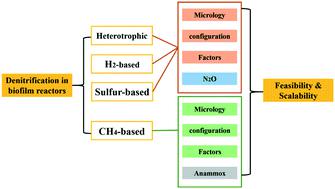当前位置:
X-MOL 学术
›
Environ. Sci.: Water Res. Technol.
›
论文详情
Our official English website, www.x-mol.net, welcomes your
feedback! (Note: you will need to create a separate account there.)
Denitrifying biofilm processes for wastewater treatment: developments and perspectives
Environmental Science: Water Research & Technology ( IF 3.5 ) Pub Date : 2020-10-6 , DOI: 10.1039/d0ew00576b Lan Wu 1, 2, 3, 4, 5 , Wei Wei 1, 2, 3, 4, 5 , Juan Xu 6, 7, 8, 9, 10 , Xueming Chen 11, 12, 13 , Yiwen Liu 1, 2, 3, 4, 5 , Lai Peng 13, 14, 15, 16 , Dongbo Wang 13, 17, 18, 19, 20 , Bing-Jie Ni 1, 2, 3, 4, 5
Environmental Science: Water Research & Technology ( IF 3.5 ) Pub Date : 2020-10-6 , DOI: 10.1039/d0ew00576b Lan Wu 1, 2, 3, 4, 5 , Wei Wei 1, 2, 3, 4, 5 , Juan Xu 6, 7, 8, 9, 10 , Xueming Chen 11, 12, 13 , Yiwen Liu 1, 2, 3, 4, 5 , Lai Peng 13, 14, 15, 16 , Dongbo Wang 13, 17, 18, 19, 20 , Bing-Jie Ni 1, 2, 3, 4, 5
Affiliation

|
Biofilms can retain microorganisms with very different growth kinetics and different electron acceptor preferences, due to their natural redox zonation. Denitrifying biofilm processes are crucial biological processes for the treatment of nitrogen-polluted water. Heterotrophic, autotrophic, and methane-supported denitrifying biofilms have been widely utilized for removing nitrogenous contaminants in recent years. Heterotrophic denitrification is a conventional approach to conduct a respiratory process with nitrate or nitrite as the terminal electron acceptor and organic carbon serving as the main electron donor. Autotrophic denitrification is a cost-effective process for nitrogen removal with reduced inorganic compounds acting as the electron donor, such as hydrogen and sulfur. Methane could also be used directly as an electron donor to drive denitrification in the methane-based denitrification process. While the controlled biofilm-based systems are capable of enhancing the nitrogen removal efficiency by these denitrifiers, this review aimed to provide a comprehensive and up-to-date summary of these important denitrifying biofilm processes in attached-growth reactors from the perspectives of microbiology, reactor configurations, controlling factors, nitrous oxide emissions, and coexistence with other microorganisms. The technical challenges and associated strategies towards improving the performance of each denitrifying biofilm process are then discussed. The outlook for the larger engineering scalability of these processes is also put forward to facilitate their applications for higher treatment capacities.
中文翻译:

用于废水处理的生物膜反硝化工艺:发展和前景
由于其天然的氧化还原带,生物膜可以保留具有非常不同的生长动力学和不同的电子受体偏好的微生物。生物膜反硝化过程是处理氮污染水的关键生物过程。近年来,异养,自养和甲烷支持的反硝化生物膜已被广泛用于去除含氮污染物。异养反硝化是一种以硝酸盐或亚硝酸盐为末端电子受体,有机碳为主要电子供体的呼吸过程。自养反硝化是一种经济高效的脱氮方法,其中还原的无机化合物可作为电子给体,例如氢和硫。甲烷也可以直接用作电子给体,以驱动基于甲烷的反硝化过程中的反硝化。尽管基于受控生物膜的系统能够提高这些反硝化器的脱氮效率,但本综述旨在从微生物学的角度为附着生长反应器中的这些重要反硝化生物膜过程提供全面而最新的概述,反应器配置,控制因素,一氧化二氮排放以及与其他微生物的共存。然后讨论了提高每个反硝化生物膜工艺性能的技术挑战和相关策略。还提出了这些方法具有更大的工程可扩展性的前景,以促进其用于更高处理能力的应用。
更新日期:2020-10-06
中文翻译:

用于废水处理的生物膜反硝化工艺:发展和前景
由于其天然的氧化还原带,生物膜可以保留具有非常不同的生长动力学和不同的电子受体偏好的微生物。生物膜反硝化过程是处理氮污染水的关键生物过程。近年来,异养,自养和甲烷支持的反硝化生物膜已被广泛用于去除含氮污染物。异养反硝化是一种以硝酸盐或亚硝酸盐为末端电子受体,有机碳为主要电子供体的呼吸过程。自养反硝化是一种经济高效的脱氮方法,其中还原的无机化合物可作为电子给体,例如氢和硫。甲烷也可以直接用作电子给体,以驱动基于甲烷的反硝化过程中的反硝化。尽管基于受控生物膜的系统能够提高这些反硝化器的脱氮效率,但本综述旨在从微生物学的角度为附着生长反应器中的这些重要反硝化生物膜过程提供全面而最新的概述,反应器配置,控制因素,一氧化二氮排放以及与其他微生物的共存。然后讨论了提高每个反硝化生物膜工艺性能的技术挑战和相关策略。还提出了这些方法具有更大的工程可扩展性的前景,以促进其用于更高处理能力的应用。











































 京公网安备 11010802027423号
京公网安备 11010802027423号